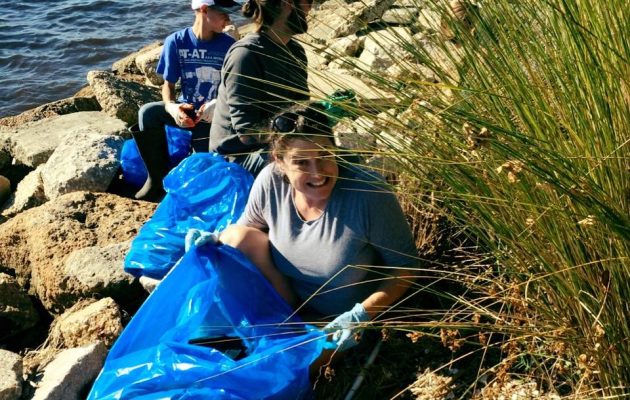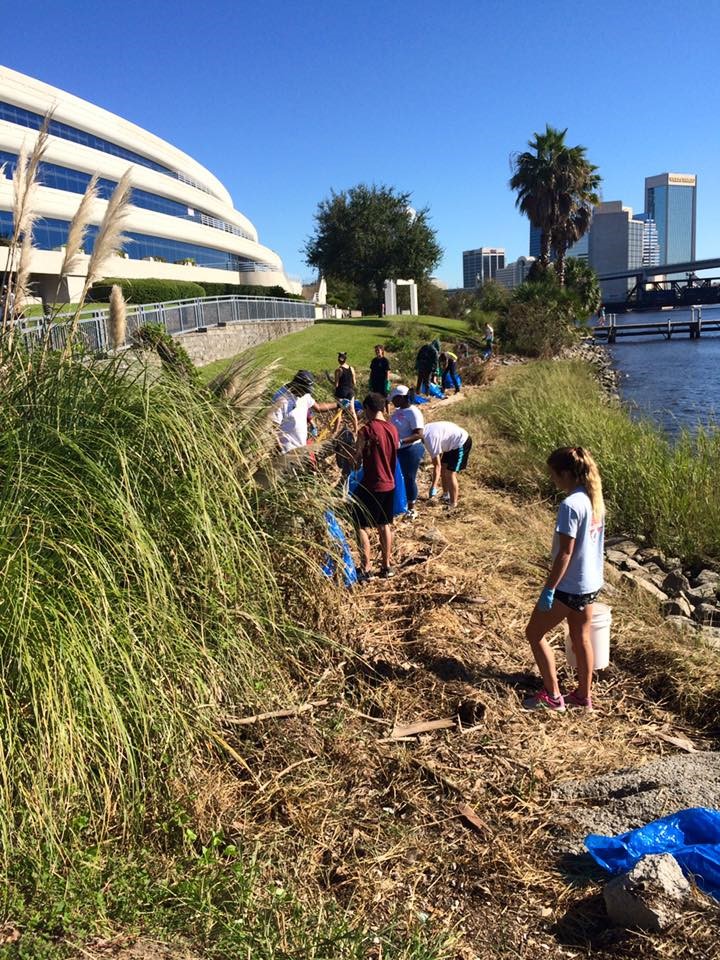Volunteers tackle post-Matthew debris on Northbank

Rising Tides, the St. Johns Riverkeeper young professionals group, took a break from its typical monthly McCoys Creek cleanups in October to spend two weekends removing debris that washed ashore along the Northbank Riverwalk during Hurricane Matthew.
Typically, McCoys Creek cleanups result in a stack of old tires and dozens of garbage bags full of plastic and glass bottles, shoes, toys and cigarette butts. For this cleanup effort, volunteers instead worked to collect wood from damaged docks and the millions of pieces of disintegrating styrofoam and tiny bits of broken plastic caught in the shoreline grasses after Matthew’s storm surge subsided.
The riverbank’s cleanup was obviously needed, but having the group of volunteers work along the Riverwalk had another benefit: visibility. McCoys Creek cleanup locations are often off the beaten path and the results not easily noticed by the public. An occasional site with higher visibility helps build awareness about how trash ends up in our waterways.
“The infrastructure in older neighborhoods was designed so that the creek and river take in stormwater during any given rainstorm. Our infrastructure just isn’t as up to date as it is in more recently developed parts of the city,” explained Murray Hill resident Shannon Blankinship, St. Johns Riverkeeper’s outreach director and regular cleanup participant.

A crew of nearly 20 cleaned up the Northbank Riverwalk after Hurricane Matthew came through. (Photo by Alicia Smith)
“There is some illegal dumping but we’re all the source and the culprits,” said Blankinship. “It’s what falls out of trash cans when people take them to the curb early or kids’ toys that were left in the yard and washed away by a rainstorm that ends up in McCoys.”
With headwaters in Murray Hill near Powers Park, McCoys Creek flows for three and a half miles through the North Riverside and Brooklyn neighborhoods before emptying into the St. Johns. The creek, in many places hidden between buildings and thick vegetation and under highly traversed roadways, has long been known as one of the most polluted waterways in the city, the result of decades of industrial runoff, wastewater discharge and neglect.
Rising Tides members, along with volunteers from Keep Jacksonville Beautiful, the UNF Environmental Center and numerous other community organizations, have been working along McCoys Creek every month since January 2013. In that time, well over 3,000 volunteer hours have been spent filling nearly 2,000 trash bags and retrieving more than 250 tires from the creek. Rising Tides members muse about their “favorite” finds, including a completely submerged 17-foot boat, a soda vending machine and the front end of a van, and are no longer surprised to come across shopping carts, bicycle frames, couches, mattresses and toilets.
Blankinship explained the original goal of the monthly cleanups was to remove dams and impediments created by years of debris buildup so the creek would start flowing freely again. Increased flow helps with biological diversity and water quality, but also brings benefits, like site-specific flood prevention.
“McCoys Creek didn’t flood during Matthew, which shows we’ve been doing a great job of clearing it out so it didn’t retain a bunch of water after the storm,” said Jonathan Addington, Murray Hill resident and Rising Tides steering committee member.
Significant progress has been made in improving the creek’s water quality and cleanup organizers can even see the creek’s potential as a recreational resource. McCoys abuts a number of existing city parks, allowing the option for public access points for paddlers. Riverside resident Alicia Smith, chair of the Rising Tides and an avid kayaker, shared that under Mayor Alvin Brown, a number of city parks adjacent to the creek were identified for designation as primitive canoe/kayak launches, but that plans have yet to be implemented.
“The groundwork is there, it’s just going to take initiative from people to restart that dialogue to get those up and going,” said Smith, who hopes that the continued cleanup efforts will help demonstrate public interest in the viability of the corridor as an urban paddling blueway. “McCoy’s is definitely an option for accessing the [St. Johns] river recreationally.”
With opportunities to get in the water (bring boots and waders if you have them), but also to collect trash along the creek bank and surrounding areas to prevent it from entering the water, cleanups are appropriate for all ages and new individuals and groups are always welcome.
The next cleanup is scheduled for Sunday, Nov. 20 at 10 a.m. at Woodstock Park, 2839 W. Beaver St. Volunteers are asked to bring drinking water in a reusable bottle and to wear closed-toe shoes. Follow Rising Tides on social media for notices of future cleanup dates and locations.
By Krysten L. Bennett






